11.3.3 Transforming and filtering reactive streams
As data flows through a stream, you’ll likely need to filter out some values and modify other values. In this section, we’ll look at operations that transform and filter the data flowing through a reactive stream.
FILTERING DATA FROM REACTIVE TYPES
One of the most basic ways of filtering data as it flows from a Flux is to simply disregard the first so many entries. The skip() operation, illustrated in figure 11.10, does exactly that.
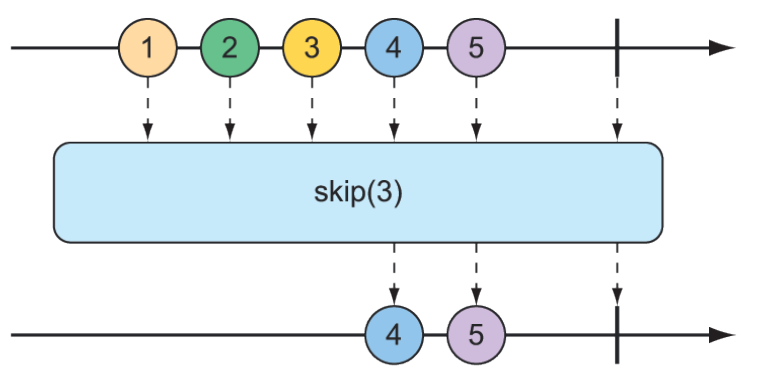 Figure 11.10 The
Figure 11.10 The skip() operation skips a specified number of messages before passing the remaining messages on to the resulting Flux.
Given a Flux with several entries, the skip() operation will create a new Flux that skips over a specified number of items before emitting the remaining items from the source Flux. The following test method shows how to use skip():
@Test
public void skipAFew() {
Flux<String> countFlux = Flux.just(
"one", "two", "skip a few", "ninety nine", "one hundred")
.skip(3);
StepVerifier.create(countFlux)
.expectNext("ninety nine", "one hundred")
.verifyComplete();
}In this case, you have a Flux of five String items. Calling skip(3) on that Flux produces a new Flux that skips over the first three items and publishes only the last two items.
But maybe you don’t want to skip a specific number of items but instead need to skip the first so many items until some duration has passed. An alternate form of the skip() operation, illustrated in figure 11.11, produces a Flux that waits until some specified time has passed before emitting items from the source Flux.
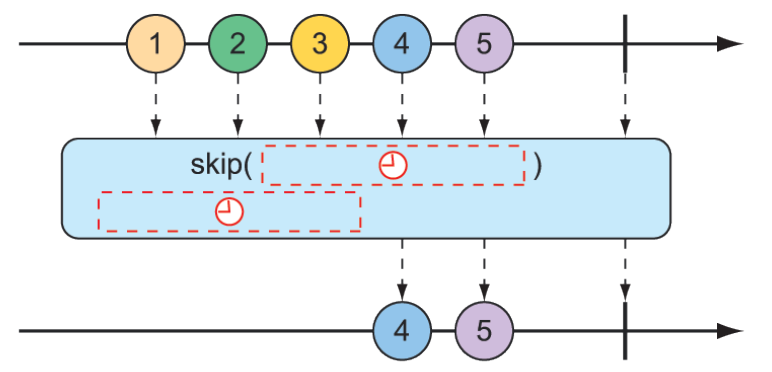 Figure 11.11 An alternative form of the
Figure 11.11 An alternative form of the skip() operation waits until some duration has passed before passing messages on to the resulting Flux.
The test method that follows uses skip() to create a Flux that waits 4 seconds before emitting any values. Because that Flux was created from a Flux that has a 1-second delay between items (using delayElements()), only the last two items will be emitted.
@Test
public void skipAFewSeconds() {
Flux<String> countFlux = Flux.just(
"one", "two", "skip a few", "ninety nine", "one hundred")
.delayElements(Duration.ofSeconds(1))
.skip(Duration.ofSeconds(4));
StepVerifier.create(countFlux)
.expectNext("ninety nine", "one hundred")
.verifyComplete();
}You’ve already seen an example of the take() operation, but in light of the skip() operation, take() can be thought of as the opposite of skip(). Whereas skip() skips the first few items, take() emits only the first so many items (as illustrated by the marble diagram in figure 11.12):
@Test
public void take() {
Flux<String> nationalParkFlux = Flux.just(
"Yellowstone", "Yosemite", "Grand Canyon", "Zion", "Acadia")
.take(3);
StepVerifier.create(nationalParkFlux)
.expectNext("Yellowstone", "Yosemite", "Grand Canyon")
.verifyComplete();
}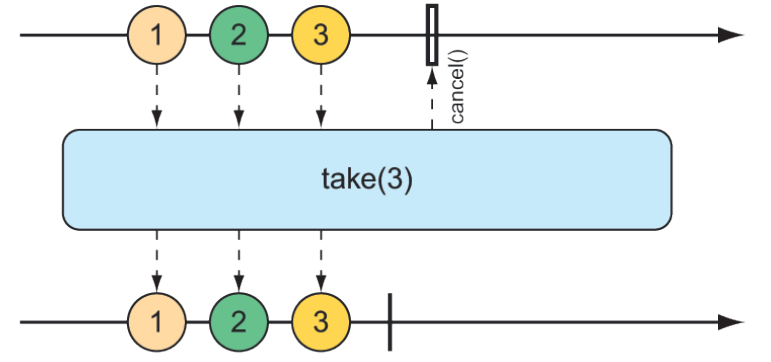 Figure 11.12 The
Figure 11.12 The take() operation passes only the first so many messages from the incoming Flux and then cancels the subscription.
Like skip(), take() also has an alternative form that’s based on a duration rather than an item count. It will take and emit as many items as pass through the source Flux until some period of time has passed, after which the Flux completes. This is illustrated in figure 11.13.
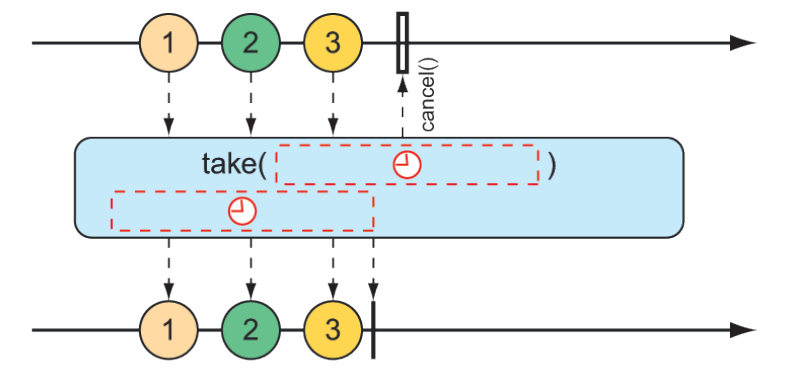 Figure 11.13 An alternative form of the
Figure 11.13 An alternative form of the take() operation passes messages on to the resulting Flux until some duration has passed.
The following test method uses the alternative form of take() to emit as many items as it can in the first 3.5 seconds after subscription:
@Test
public void takeForAwhile() {
Flux<String> nationalParkFlux = Flux.just(
"Yellowstone", "Yosemite", "Grand Canyon", "Zion", "Grand Teton")
.delayElements(Duration.ofSeconds(1))
.take(Duration.ofMillis(3500));
StepVerifier.create(nationalParkFlux)
.expectNext("Yellowstone", "Yosemite", "Grand Canyon")
.verifyComplete();
}The skip() and take() operations can be thought of as filter operations where the filter criteria are based on a count or a duration. For more general-purpose filtering of Flux values, you’ll find the filter() operation quite useful.
Given a Predicate that decides whether an item will pass through the Flux, the filter() operation lets you selectively publish based on whatever criteria you want. The marble diagram in figure 11.14 shows how filter() works.
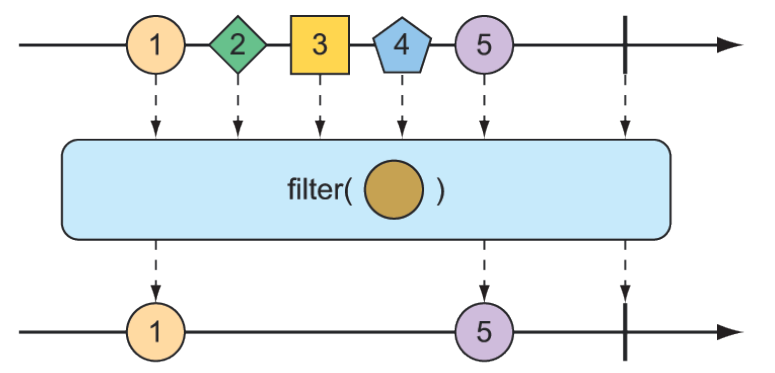 Figure 11.14 An incoming
Figure 11.14 An incoming Flux can be filtered so that the resulting Flux receives only messages that match a given predicate.
To see filter() in action, consider the following test method:
@Test
public void filter() {
Flux<String> nationalParkFlux = Flux.just(
"Yellowstone", "Yosemite", "Grand Canyon", "Zion", "Grand Teton")
.filter(np -> !np.contains(" "));
StepVerifier.create(nationalParkFlux)
.expectNext("Yellowstone", "Yosemite", "Zion")
.verifyComplete();
}Here, filter() is given a Predicate as a lambda that accepts only String values that don’t have any spaces. Consequently, "Grand Canyon" and "Grand Teton" are filtered out of the resulting Flux.
Perhaps the filtering you need is to filter out any items that you’ve already received. The distinct() operation, as illustrated in figure 11.15, results in a Flux that publishes only items from the source Flux that haven’t already been published.
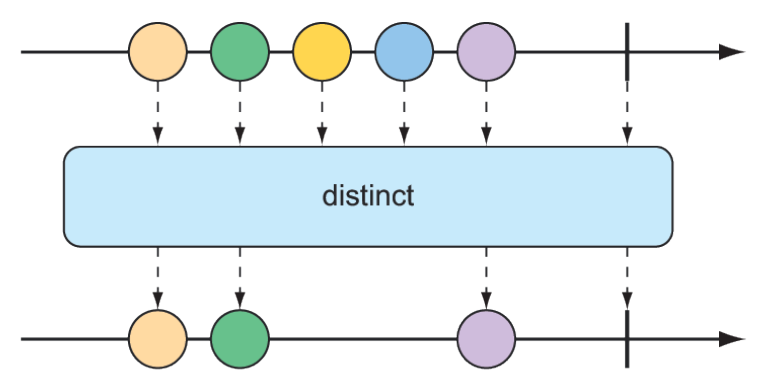 Figure 11.15 The
Figure 11.15 The distinct() operation filters out any duplicate messages.
In the following test, only unique String values will be emitted from the distinct Flux:
@Test
public void distinct() {
Flux<String> animalFlux = Flux.just(
"dog", "cat", "bird", "dog", "bird", "anteater")
.distinct();
StepVerifier.create(animalFlux)
.expectNext("dog", "cat", "bird", "anteater")
.verifyComplete();
}Although "dog" and "bird" are each published twice from the source Flux, the distinct Flux publishes them only once.
MAPPING REACTIVE DATA
One of the most common operations you’ll use on either a Flux or a Mono is to transform published items to some other form or type. Reactor’s types offer map() and flatMap() operations for that purpose.
The map() operation creates a Flux that simply performs a transformation as prescribed by a given Function on each object it receives before republishing it. Figure 11.16 illustrates how the map() operation works.
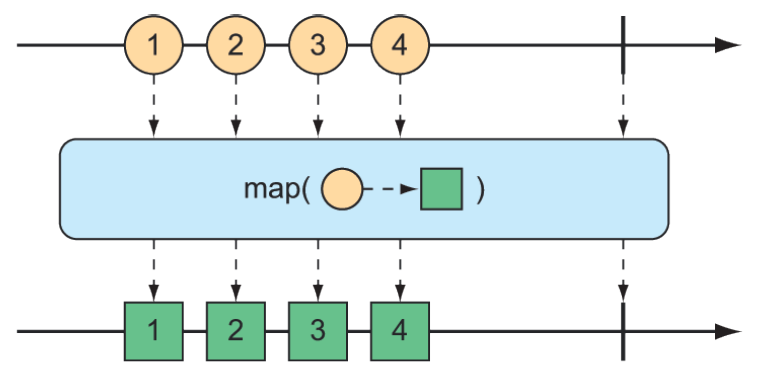 Figure 11.16 The
Figure 11.16 The map() operation performs a transformation of incoming messages into new messages on the resulting stream.
In the following test method, a Flux of String values representing basketball players is mapped to a new Flux of Player objects:
@Test
public void map() {
Flux<Player> playerFlux = Flux
.just("Michael Jordan", "Scottie Pippen", "Steve Kerr")
.map(n -> {
String[] split = n.split("\\s");
return new Player(split[0], split[1]);
});
StepVerifier.create(playerFlux)
.expectNext(new Player("Michael", "Jordan"))
.expectNext(new Player("Scottie", "Pippen"))
.expectNext(new Player("Steve", "Kerr"))
.verifyComplete();
}
@Data
private static class Player {
private final String firstName;
private final String lastName;
}The Function given to map() (as a lambda) splits the incoming String at a space and uses the resulting String array to create a Player object. Although the Flux created with just() carried String objects, the Flux resulting from map() carries Player objects.
What’s important to understand about map() is that the mapping is performed synchronously, as each item is published by the source Flux. If you want to perform the mapping asynchronously, you should consider the flatMap() operation.
The flatMap() operation requires some thought and practice to acquire full proficiency. As shown in figure 11.17, instead of simply mapping one object to another, as in the case of map(), flatMap() maps each object to a new Mono or Flux. The results of the Mono or Flux are flattened into a new resulting Flux. When used along with subscribeOn(), flatMap() can unleash the asynchronous power of Reactor’s types.
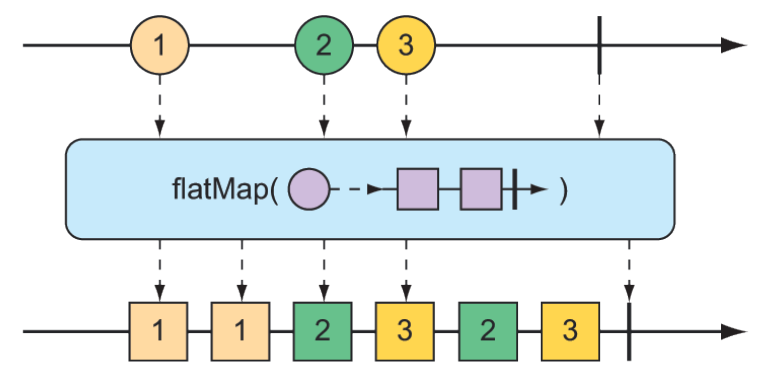 Figure 11.17 The flatMap() operation uses an intermediate Flux to perform a transformation, consequently allowing for asynchronous transformations.
Figure 11.17 The flatMap() operation uses an intermediate Flux to perform a transformation, consequently allowing for asynchronous transformations.
The following test method demonstrates the use of flatMap() and subscribeOn():
@Test
public void flatMap() {
Flux<Player> playerFlux = Flux
.just("Michael Jordan", "Scottie Pippen", "Steve Kerr")
.flatMap(n -> Mono.just(n)
.map(p -> {
String[] split = p.split("\\s");
return new Player(split[0], split[1]);
})
.subscribeOn(Schedulers.parallel())
);
List<Player> playerList = Arrays.asList(
new Player("Michael", "Jordan"),
new Player("Scottie", "Pippen"),
new Player("Steve", "Kerr"));
StepVerifier.create(playerFlux)
.expectNextMatches(p -> playerList.contains(p))
.expectNextMatches(p -> playerList.contains(p))
.expectNextMatches(p -> playerList.contains(p))
.verifyComplete();
}Notice that flatMap() is given a lambda Function that transforms the incoming String into a Mono of type String. A map() operation is then applied to the Mono to transform the String into a Player. After the String is mapped to a Player on each internal Flux, they are published into a single Flux returned by flatMap(), thus completing the flattening of the results.
If you stopped right there, the resulting Flux would carry Player objects, produced synchronously in the same order as with the map() example. But the last thing you do with the Mono is call subscribeOn() to indicate that each subscription should take place in a parallel thread. Consequently, the mapping operations for multiple incoming String objects can be performed asynchronously and in parallel.
Although subscribeOn() is named similarly to subscribe(), they’re quite different. Whereas subscribe() is a verb, subscribing to a reactive flow and effectively kicking it off, subscribeOn() is more descriptive, specifying how a subscription should be handled concurrently. Reactor doesn’t force any particular concurrency model; it’s through subscribeOn() that you can specify the concurrency model, using one of the static methods from Schedulers, that you want to use. In this example, you used parallel(), which uses worker threads from a fixed pool (sized to the number of CPU cores). But Schedulers supports several concurrency models, such as those described in table 11.1.
Table 11.1 Concurrency models for Schedulers
| Schedulers method | Description |
|---|---|
| .immediate() | Executes the subscription in the current thread |
| .single() | Executes the subscription in a single, reusable thread. Reuses the same thread for all callers |
| .newSingle() | Executes the subscription in a per-call dedicated thread |
| .elastic() | Executes the subscription in a worker pulled from an unbounded, elastic pool. New worker threads are created as needed, and idle workers are disposed of (by default, after 60 seconds) |
| .parallel() | Executes the subscription in a worker pulled from a fixed-size pool, sized to the number of CPU cores. |
The upside to using flatMap() and subscribeOn() is that you can increase the throughput of the stream by splitting the work across multiple parallel threads. But because the work is being done in parallel, with no guarantees on which will finish first, there’s no way to know the order of items emitted in the resulting Flux. Therefore, StepVerifier is able to verify only that each item emitted exists in the expected list of Player objects and that there will be three such items before the Flux completes.
BUFFERING DATA ON A REACTIVE STREAM
In the course of processing the data flowing through a Flux, you might find it helpful to break the stream of data into bite-size chunks. The buffer() operation, shown in figure 11.18, can help with that.
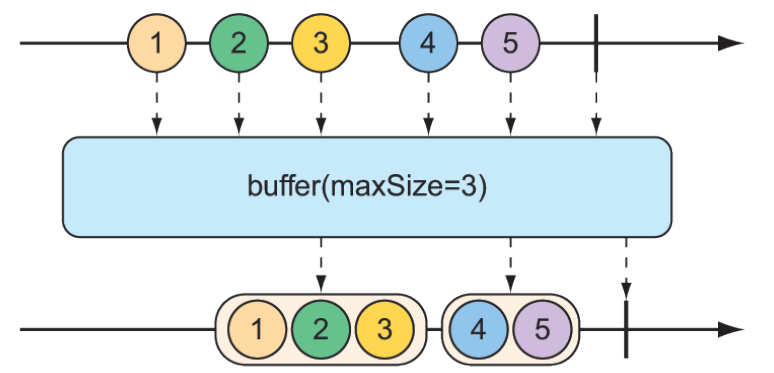 Figure 11.18 The
Figure 11.18 The buffer() operation results in a Flux of lists of a given maximum size that are collected from the incoming Flux.
Given a Flux of String values, each containing the name of a fruit, you can create a new Flux of List collections, where each List has no more than a specified number of elements as follows:
@Test
public void buffer() {
Flux<String> fruitFlux = Flux.just(
"apple", "orange", "banana", "kiwi", "strawberry");
Flux<List<String>> bufferedFlux = fruitFlux.buffer(3);
StepVerifier
.create(bufferedFlux)
.expectNext(Arrays.asList("apple", "orange", "banana"))
.expectNext(Arrays.asList("kiwi", "strawberry"))
.verifyComplete();
}In this case, the Flux of String elements is buffered into a new Flux of List collections containing no more than three items each. Consequently, the original Flux that emits five String values will be converted to a Flux that emits two List collections, one containing three fruits and the other with two fruits.
So what? Buffering values from a reactive Flux into nonreactive List collections seems counterproductive. But when you combine buffer() with flatMap(), it enables each of the List collections to be processed in parallel, as shown next:
@Test
public void bufferAndFlatMap() throws Exception {
Flux.just(
"apple", "orange", "banana", "kiwi", "strawberry")
.buffer(3)
.flatMap(x ->
Flux.fromIterable(x)
.map(y -> y.toUpperCase())
.subscribeOn(Schedulers.parallel())
.log()
).subscribe();
}In this new example, you still buffer a Flux of five String values into a new Flux of List collections. But then you apply flatMap() to that Flux of List collections. This takes each List buffer and creates a new Flux from its elements, and then applies a map() operation on it. Consequently, each buffered List is further processed in parallel in individual threads.
To prove that it works, I’ve also included a log() operation to be applied to each sub-Flux. The log() operation simply logs all Reactive Streams events, so that you can see what’s really happening. As a result, the following entries are written to the log (with the time component removed for brevity’s sake):
[main] INFO reactor.Flux.SubscribeOn.1 - onSubscribe(FluxSubscribeOn.SubscribeOnSubscriber)
[main] INFO reactor.Flux.SubscribeOn.1 - request(32)
[main] INFO reactor.Flux.SubscribeOn.2 - onSubscribe(FluxSubscribeOn.SubscribeOnSubscriber)
[main] INFO reactor.Flux.SubscribeOn.2 - request(32)
[parallel-1] INFO reactor.Flux.SubscribeOn.1 - onNext(APPLE)
[parallel-2] INFO reactor.Flux.SubscribeOn.2 - onNext(KIWI)
[parallel-1] INFO reactor.Flux.SubscribeOn.1 - onNext(ORANGE)
[parallel-2] INFO reactor.Flux.SubscribeOn.2 - onNext(STRAWBERRY)
[parallel-1] INFO reactor.Flux.SubscribeOn.1 - onNext(BANANA)
[parallel-1] INFO reactor.Flux.SubscribeOn.1 - onComplete()
[parallel-2] INFO reactor.Flux.SubscribeOn.2 - onComplete()As the log entries clearly show, the fruits in the first buffer (apple, orange, and banana) are handled in the parallel-1 thread. Meanwhile, the fruits in the second buffer (kiwi and strawberry) are processed in the parallel-2 thread. As is apparent by the fact that the log entries from each buffer are woven together, the two buffers are processed in parallel.
If, for some reason, you need to collect everything that a Flux emits into a List, you can call buffer() with no arguments as follows:
Flux<List<List>> bufferedFlux = fruitFlux.buffer();This results in a new Flux that emits a List that contains all the items published by the source Flux. You can achieve the same thing with the collectList() operation, illustrated by the marble diagram in figure 11.19.
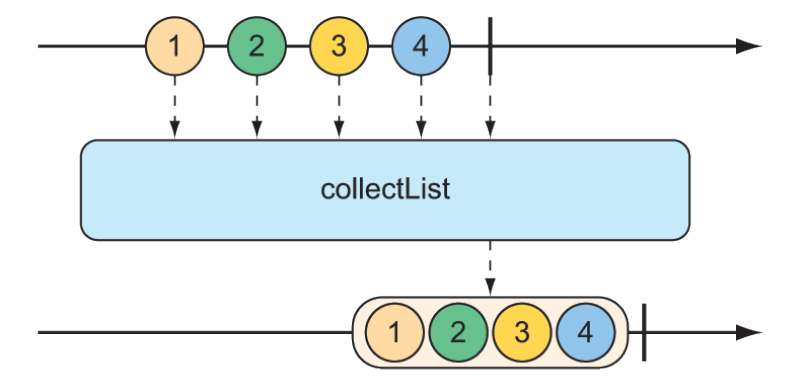 Figure 11.19 The
Figure 11.19 The collectList() operation results in a Mono containing a list of all messages emitted by the incoming Flux.
Rather than produce a Flux that publishes a List, collectList() produces a Mono that publishes a List. The following test method shows how it might be used:
@Test
public void collectList() {
Flux<String> fruitFlux = Flux.just(
"apple", "orange", "banana", "kiwi", "strawberry");
Mono<List<String>> fruitListMono = fruitFlux.collectList();
StepVerifier
.create(fruitListMono)
.expectNext(Arrays.asList(
"apple", "orange", "banana", "kiwi", "strawberry"))
.verifyComplete();
}An even more interesting way of collecting items emitted by a Flux is to collect them into a Map. As shown in figure 11.20, the collectMap() operation results in a Mono that publishes a Map that’s populated with entries whose key is calculated by a given Function.
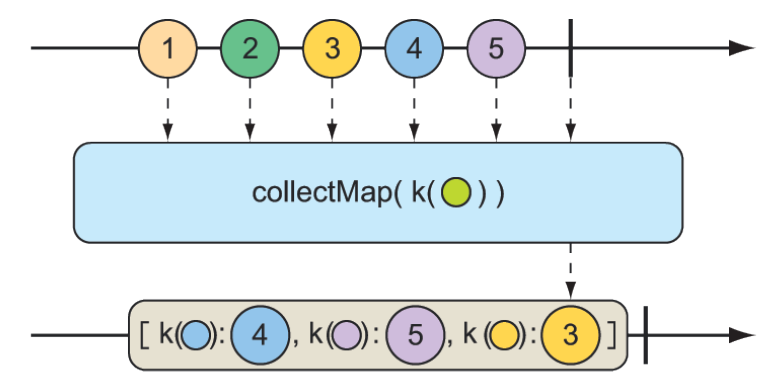 Figure 11.20 The
Figure 11.20 The collectMap() operation results in a Mono containing a map of messages emitted by the incoming Flux, where the key is derived from some characteristic of the incoming messages.
To see collectMap() in action, have a look at the following test method:
@Test
public void collectMap() {
Flux<String> animalFlux = Flux.just(
"aardvark", "elephant", "koala", "eagle", "kangaroo");
Mono<Map<Character, String>> animalMapMono =
animalFlux.collectMap(a -> a.charAt(0));
StepVerifier
.create(animalMapMono)
.expectNextMatches(map -> {
return
map.size() == 3 &&
map.get('a').equals("aardvark") &&
map.get('e').equals("eagle") &&
map.get('k').equals("kangaroo");
})
.verifyComplete();
}The source Flux emits the names of a handful of animals. From that Flux, you use collectMap() to create a new Mono that emits a Map, where the key value is determined by the first letter of the animal name and the value is the animal name itself. In the event that two animal names start with the same letter (as with elephant and eagle or koala and kangaroo), the last entry flowing through the stream overrides any earlier entries.
